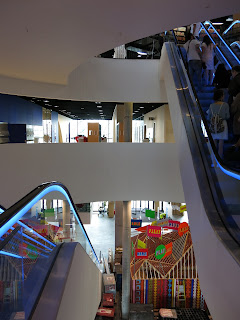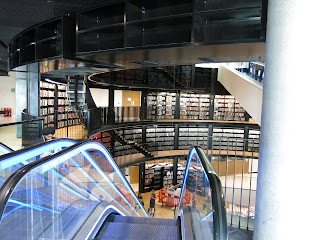Opening the book
The new Library of Birmingham opens in a few hours time today on Tuesday 3 September and after five years of design, planning and construction it's much anticipated arrival heralds a new renaissance for the city, a day before the Bullring celebrates it's tenth anniversary and reflects on it's own retail renaissance for the city.
With a building making a statement on the value of learning and ideas it is fitting that it will be opened by teenage women's rights campaigner Malala Yousafzai, http://www.birminghammail.co.uk/news/local-news/malala-yousafzai-open-library-birmingham-5826853, who was shot by the Taliban for campaigning for women's rights and treated at Birmingham's Queen Elizabeth Hospital.
Malala, who was treated at the Queen Elizabeth Hospital in Birmingham following her near-fatal shooting in Pakistan, will receive membership of the Library of Birmingham before delivering a speech and unveiling a commemorative plaque on Tuesday September 3.
The opening ceremony will begin at 11am and will be attended by Ed Vaizey MP, Minister for Culture together with The Lord Mayor, Coun Mike Leddy, Coun Ian Ward, Deputy Leader of Birmingham city Council, Brian Gambes, Director of The Library of Birmingham, and the architect Francine Houben.
Thursday 29 August was embargo day and the embargo for press reviewers and those lucky enough to get a sneak peak of the interior was lifted so the world could await with frenzied anticipation it's opening on Tuesday 3 September. If you missed any of the articles or reports on the building then you must have been sleeping as it was profiled on BBC Midlands Today and over 30 newspapers, journals and magazines aside from bloggers and social media reporters such as myself together with the rash of pictures being published across twitter, tumblr, facebook and flickr.
Some of my pictures from the press tour and soft testing day, http://birminghamcentral.blogspot.com/2013/08/six-days-till-brums-peoples-palace-opens.html, are shown below but in never more truer words it has to be seen and experienced - pictures do not do it justice.
So what's in the new library? Several newspapers have shown the cut through picture to show the scale of the library and it's worth reproducing to show the the flow of the building and what's on the many levels, http://www.birminghampost.co.uk/news/local-news/whats-inside-library-birmingham-5800011?utm_source=twitterfeed&utm_medium=twitter.
While there will be books in the Shakespeare Memorial Room most of the library's Shakespeare collection will be safely preserved in the archive levels. The collection includes a copy of the First Folio printed in 1623 as well as editions of plays in hundreds of languages together with ephemeral pieces such as posters, programmes and publications, http://www.obsessionistas.co.uk/library-of-birmingham/
The archives in contrast to being buried in the ground take pride of place in the golden archive levels of the fifth and sixth floors which have no windows to provide perfect archival conditions. The archive structure is designed to be fire resistant for over two hours and is a dedicated hypoxic environment containing high nitrogen levels to reduce fire risk, http://www.construction-manager.co.uk/features/heres-twist/. The need to ensure the best conditions for the archives and collections reflects the amazing collections it holds. The Early and Fine Printing collection is made up of 13,000 volumes, 8,000 of which were printed before 1701 while the library also holds a copy of James Audubon's Birds of America, in four volumes which each measure 91cm by 61cm and include hand-coloured drawings all life-size.
Connecting all these levels and what the images and plans above show with the book rotunda and escalators zig-zagging through the building is the open interlocking rotundas that act both to invite light into the open spaces throughout the library but allow natural ventilation as heat rises to the roof to escape through vents.
The zig-zags of escalators and the the interlocking rotundas also invite you to explore the library as you cannot see it all at once. You are encouraged to go on a journey through the library and on a journey through learning which Houben says is to "mirror the path to knowledge, to be a journey of exploration where everything is not instantly revealed, but uncovered by stages as you move towards the tope of the building", http://www.building.co.uk/library-of-birmingham-the-borrowers/5059357.article.
For those who are wondering if there are any books left for the library with all the space and openness it's quite amazing to think that the new library will display 40 per cent of it's stock, up from 13 per cent in the former Central Library, http://www.telegraph.co.uk/culture/art/architecture/10266749/The-Library-of-Birmingham-first-look.html; the library will display 400,000 books on its shelves. There are also 600,000 books in storage areas. It's hard to imagine how it all fits in.
Plans showing the main floors are reproduced from Building Design, http://www.bdonline.co.uk/buildings/library-of-birmingham-by-mecanoo/5059729.article
Just before the opening, the 16-year-old will put in place the very last book on the shelves of the new Library - her own copy of The Alchemist by Paolo Coelho.
http://www.birminghammail.co.uk/news/local-news/malala-yousafzai-open-library-birmingham-5826853
She added: "The content of a book holds the power of education and it is with this power that we can shape our future and change lives.
"There is no greater weapon than knowledge and no greater source of knowledge than the written word.
The atmosphere of excitement is palpable as the opening date has crept closer and while marking a key part of the regeneration of the city and it's continuing renaissance alongside a redeveloped New Street Station it could perhaps mark a last hurrah for big civic projects as the Guardian argues in a time of austerity, http://www.theguardian.com/commentisfree/2013/sep/01/birmingham-library-last-hurrah-civic-britain. Indeed the library is perhaps the final max libris as Independent writer Jay Merrick suggests, http://www.independent.co.uk/voices/commentators/is-this-the-last-hurrah-for-modern-bookish-bigness-8788534.html, following the 2007 massive British Library.
"It is my dream that one day, great buildings like this one will exist in every corner of the world so every child can grow up with the opportunity to succeed."
http://www.bbc.co.uk/news/uk-england-birmingham-23929310
The Library of Birmingham is a fabulous public space, less a library, more an attempt to create an open information hub for the city – surely the only future for libraries as they shudder before the twin impact of the digital revolution and the cruellest, fastest withdrawal of local public spending from any major industrialised country since 1945.
http://www.theguardian.com/commentisfree/2013/sep/01/birmingham-library-last-hurrah-civic-britain
The survival of the project amongst a battlefield of spending cuts and arguments over public spending both national and local was due to the decision to proceed with the development in 2007 a year before the financial crisis. If the decision had been taken later this ambitious project would not have happened and a city that has seen grand projects continue it's renaissance and embody it's civic pride in structural form would have lost the impetus that the building stands for. The building, aside from it's own comments on learning and the future of the library, acts as a visible statement of intent that Birmingham is looking forward and seeking to continue it's regeneration and a beacon to investors that Birmingham is bold and forward looking. This is the fourth central library for the city and in a young city with a rich industrial and creative history it shouts loudly that this city is in the words of it's city motto -moving Forward.
There is also a tale of ambition and tension with a project that looked like it might be a victim of city politics between competing administrations after the 2002 appointment of Rogers Stirk Harbour & Partners to develop a new library in Eastside was cancelled over fear of costs and the peripheral location for the library, http://www.bdonline.co.uk/buildings/library-of-birmingham-by-mecanoo/5059729.article. The cancellation of that project on the election of a new administration and the need to ensure this project started before it too could be cancelled with any change in council administration makes it's completion all the more impressive. You can wonder however what the Rogers design would have achieved with Rogers' focus on the human and the involvement of people in spaces and his work on the Pompidou Centre in Paris or Lloyds Building in London, http://birminghamcentral.blogspot.co.uk/2009/03/countdown-to-library-of-birmingham.html.
Having been to the Royal Academy Inside Out exhibition recently it would have been exciting to see Rogers' views on design and space help challenge a city more known for putting people into underpasses and giving priority to the car. The new library does I believe help realise some of Rogers' views internally and in many articles and from my own viewing of the inside I believe that while I personally enjoy the exterior it does overshadow the true majesty which is the interior.
The new Library of Birmingham may be loud on the outside but inside it's an enchanting temple of calm; http://www.telegraph.co.uk/culture/art/architecture/10266749/The-Library-of-Birmingham-first-look.html
It's also a story of engineering creativity with what Construction Manager, the magazine of the Chartered Institute of Building, calling 'engineering gymnastics to ensure structural integrity', http://www.construction-manager.co.uk/features/heres-twist/. From the initial idea of a steel structure concrete was chosen due to acoustics and fire protection which presented it's own challenges in a building where every floor is different in loadings and use. The steel of the 'book wall' for example between levels three and five ties slabs together to let them share load. The bespoke and innovative approach to reflecting the architects ambitions with the reality of construction have produced a building that is fascinating architecturally as much as it is internally in it's role.
The division between square and interior is further softened by the cantilevering forward of the building’s first and second floors by a formidable 11.5m, and by the enclosure of the double-height lobby set beneath in full-height glass; http://www.bdonline.co.uk/buildings/library-of-birmingham-by-mecanoo/5059729.article
Crowning the building and acting perhaps as an intellectual beacon for the midlands shining with a golden exterior is the Shakespeare Memorial Room. Within the golden rotunda which features a viewing gallery to look out across the city is the memorial room which is the oldest part of the new library being a survivor of the second city library. Having been dismantled when the 1882 Victorian Library was replaced by John Madin's Central Library in 1974 it was reconstructed some 12 years later after the opening of Madin's library in the School of Music next door before being dismantled again and moved to the new Library of Birmingham.
The basement is however not a bleak hidden space; containing the music and children's library with daylight filling the space through the open amphitheatre it will be a bubbling invitation to explore and interact. There's even the chance to make your own music with rehearsal rooms and a digital recording studio available to hire.
Mecanoo founder Francine Houben admits to being “fascinated” by the series of railway lines, tunnels, roads and underpasses often hidden beneath the city, a sensation compounded by the overwhelmingly flat composition of her native Netherlands. The rotunda is partially devised as a means of “exposing” this typology. http://www.building.co.uk/library-of-birmingham-the-borrowers/5059357.article
Ascending through the glistening layers of the new building, it seems that a library of the 21st century follows a similar model to Madin's scheme, but at a much bigger scale. Expansive open-plan floors are once again linked with weaving flights of escalators, only here they are suspended precipitously through dramatic interlocking rotundas, which climb from the cavernous lending library terraces, up through floating rings of bookshelves, to the heavenly reaches of the light-flooded atrium above. It is a finely-tuned sequence of level changes and alluring glimpses, more familiar to the world of shopping malls and airport terminals than a repository of knowledge.
"We don't know what the future of the library will be," says Houben, "so we have designed space for change, to last over the next 100 years." With up to 10,000 visitors a day expected, the floors are designed with copious spaces for studying, meeting, working and gossiping on the usual range of soft seating, tables and perches. While the old library could be dingy in places, the floors of the new building are washed with daylight, with a continuous line of desks around the floor-to-ceiling windows. In fact the only thing missing from these bright, light, interconnected floors are cosy reading rooms – somewhere removed from the endless through-traffic of visitors pouring up the rotunda.
http://www.theguardian.com/artanddesign/2013/aug/29/birmingham-new-library-architecture



















































Comments